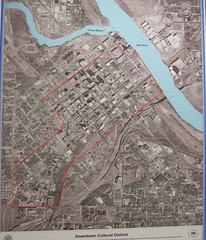Goal: that students demonstrate knowledge that there are many ways to scientifically create maps.
See this article and illustrations at the US Geological Survey site.
A map projection is used to portray all or part of the round Earth on a flat surface. This cannot be done without some distortion.
Every projection has its own set of advantages and disadvantages. There is no "best" projection.
The mapmaker must select the one best suited to the needs, reducing distortion of the most important features.
Mapmakers and mathematicians have devised almost limitless ways to project the image of the globe onto paper. Scientists at the U. S. Geological Survey have designed projections for their specific needs—such as the Space Oblique Mercator, which allows mapping from satellites with little or no distortion.
This document gives the key properties, characteristics, and preferred uses of many historically important projections and of those frequently used by mapmakers today.
Which ones best suit your needs?
Every flat map misrepresents the surface of the Earth in some way. No map can rival a globe in truly representing the surface of the entire Earth. However, a map or parts of a map can show one or more—but never all—of the following: True directions. True distances. True areas. True shapes.
For example, the basic Mercator projection is unique; it yields the only map on which a straight line drawn anywhere within its bounds shows a particular type of direction, but distances and areas are grossly distorted near the map's polar regions.
On an equidistant map, distances are true only along particular lines such as those radiating from a single point selected as the center of the projection. Shapes are more or less distorted on every equal-area map. Sizes of areas are distorted on conformal maps even though shapes of small areas are shown correctly. The degree and kinds of distortion vary with the projection used in making a map of a particular area. Some projections are suited for mapping large areas that are mainly north-south in extent, others for large areas that are mainly east-west in extent, and still others for large areas that are oblique to the Equator.
The scale of a map on any projection is always important and often crucial to the map's usefulness for a given purpose. For example, the almost grotesque distortion that is obvious at high latitudes on a small-scale Mercator map of the world disappears almost completely on a properly oriented large-scale Transverse Mercator map of a small area in the same high latitudes. A large-scale (1:24,000) 7.5-minute USGS Topographic Map based on the Transverse Mercator projection is nearly correct in every respect.
A basic knowledge of the properties of commonly used projections helps in selecting a map that comes closest to fulfilling a specific need.
skip to main |
skip to sidebar
For students and parents who love education and exploration of the social sciences . . .
Search This Blog
Followers
Blog Archive
-
▼
2010
(346)
-
▼
August
(27)
- Quiz on the background of the Caddo peoples
- Project on the Five Themes of Geography as they ap...
- In-class project: Atlantic storm tracking map
- Basics of geography: the projections used in const...
- Open notes, multiple choice quiz on Th/Fr: identif...
- Mississippi valley map quiz Tues/Wed: 15 pts on me...
- Holistic teaching: kinesiology, oxygenation and st...
- Fifth anniversary of the flooding of New Orleans a...
- Spaceship earth: teaching and using the system of ...
- Indigenous peoples: the original inhabitants
- What does a Hydrologist do?
- Fruit or nuts as a school day snack, rather than c...
- Mimal & Wiktm and mnemonics
- Spaceship Earth teaching project
- Notes on population, Ramadan and coordinates
- The implications of 6.8 billion people
- Enrichment reading: the history of navigation
- Multiple choice, open notes test: first quiz in ge...
- World geography project: latitude & longitude revi...
- World Geography additional text: The 2009 World Al...
- What's for lunch this week: Pimento Cheese sandwich
- Out of print: the long-valued Rand McNally Quick R...
- "Caddo:" what's the background of the name of this...
- Looking historically at the name "Caddo" - a diagn...
- Class of 2014 Talent Show performance night schedu...
- Water Bottle represents an industry that is far fr...
- US no longer leads in college degrees, ages 25 to ...
-
▼
August
(27)

